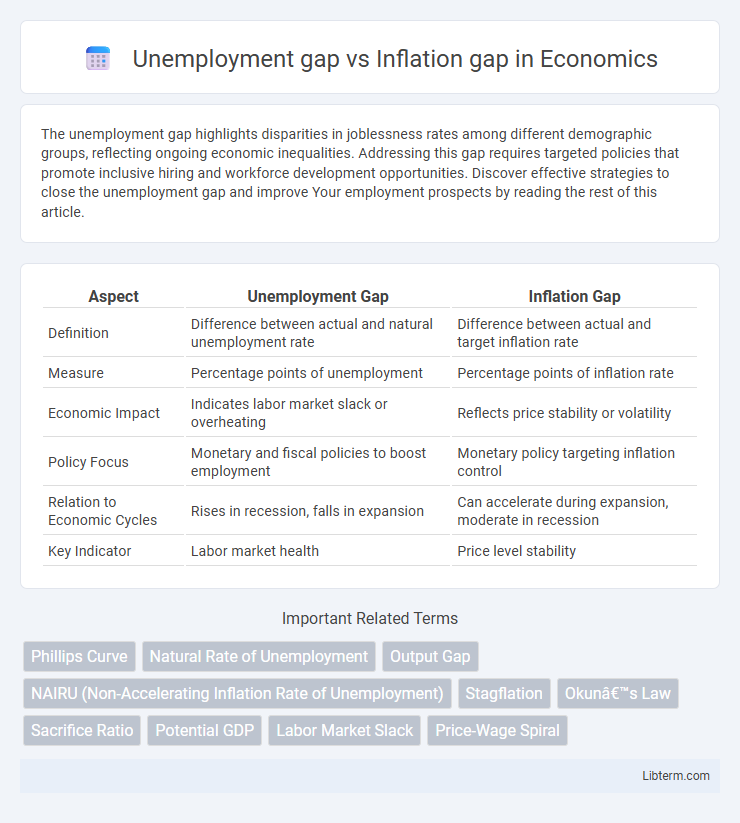The unemployment gap highlights disparities in joblessness rates among different demographic groups, reflecting ongoing economic inequalities. Addressing this gap requires targeted policies that promote inclusive hiring and workforce development opportunities. Discover effective strategies to close the unemployment gap and improve Your employment prospects by reading the rest of this article.
Table of Comparison
| Aspect | Unemployment Gap | Inflation Gap |
|---|---|---|
| Definition | Difference between actual and natural unemployment rate | Difference between actual and target inflation rate |
| Measure | Percentage points of unemployment | Percentage points of inflation rate |
| Economic Impact | Indicates labor market slack or overheating | Reflects price stability or volatility |
| Policy Focus | Monetary and fiscal policies to boost employment | Monetary policy targeting inflation control |
| Relation to Economic Cycles | Rises in recession, falls in expansion | Can accelerate during expansion, moderate in recession |
| Key Indicator | Labor market health | Price level stability |
Introduction to Unemployment and Inflation Gaps
Unemployment gap measures the difference between the actual unemployment rate and the natural rate of unemployment, indicating labor market underperformance. Inflation gap represents the deviation of actual inflation from the target inflation rate set by central banks, reflecting price stability challenges. Both gaps serve as key indicators for monetary policymakers to adjust interest rates and manage economic growth effectively.
Defining the Unemployment Gap
The unemployment gap measures the difference between the actual unemployment rate and the natural rate of unemployment, indicating underutilized labor capacity in the economy. It serves as a key indicator to assess economic slack and potential output shortfalls. Understanding the unemployment gap is critical for evaluating inflationary pressures since deviations from the natural unemployment rate influence wage growth and price stability.
What Is the Inflation Gap?
The inflation gap measures the difference between the actual inflation rate and the central bank's target inflation rate, indicating whether inflation is above or below desired levels. This gap helps policymakers assess inflationary pressures and adjust monetary policy accordingly to stabilize prices. Understanding the inflation gap is crucial for managing economic growth without triggering excessive inflation or deflation.
Theoretical Foundations: Phillips Curve Perspective
The Phillips Curve illustrates an inverse relationship between the unemployment gap and the inflation gap, suggesting that lower unemployment rates typically correlate with higher inflation rates due to increased wage pressures. Theoretical foundations emphasize that when the actual unemployment rate falls below the natural rate, demand-pull inflation arises, widening the inflation gap. Expectations-augmented Phillips Curve further refines this by integrating adaptive or rational expectations, asserting that only unexpected inflation affects unemployment, reinforcing a short-term trade-off between the unemployment gap and the inflation gap.
Causes Behind the Unemployment Gap
The unemployment gap arises when the actual unemployment rate deviates from the natural rate due to cyclical factors such as economic recessions, structural changes in industries, or labor market mismatches. Causes include demand shocks leading to reduced hiring, technological advancements causing skill obsolescence, and policy restrictions affecting labor flexibility. These factors create discrepancies between labor supply and demand, widening the unemployment gap despite stable inflation levels.
Drivers of the Inflation Gap
The inflation gap is primarily driven by demand-pull factors, where aggregate demand exceeds aggregate supply, leading to upward pressure on prices. Cost-push inflation, caused by rising wages and input costs, also contributes significantly to widening the inflation gap. Expectations of future inflation further exacerbate the inflation gap by influencing wage negotiations and pricing strategies.
Interaction Between Unemployment and Inflation Gaps
The interaction between unemployment and inflation gaps is crucial for understanding economic stability, as deviations of actual unemployment from its natural rate often correspond inversely with deviations of actual inflation from its target rate. The Phillips curve framework illustrates this inverse relationship, where a positive unemployment gap typically signals lower inflation pressure, while a negative gap aligns with rising inflation. Policymakers utilize these dynamics to balance monetary interventions, aiming to minimize both unemployment and inflation gaps to sustain economic growth and price stability.
Policy Implications and Economic Consequences
The unemployment gap, representing the difference between actual and natural unemployment rates, influences inflation pressures as low unemployment often triggers wage increases and higher inflation. Policymakers face trade-offs in using fiscal or monetary tools to balance inflation targeting against job creation, with tight policies risking recession and loose policies fueling inflation. Ignoring these gaps can lead to persistent economic instability, where excessive inflation erodes purchasing power and high unemployment depresses demand and growth.
Historical Case Studies: Unemployment vs Inflation Gaps
Historical case studies of unemployment and inflation gaps reveal critical insights into economic policy responses and their effectiveness. The 1970s stagflation exemplifies a period where high unemployment gaps coincided with significant inflation gaps, challenging traditional Phillips curve assumptions. Analysis of the Volcker era shows how tight monetary policy successfully reduced inflation gaps but initially widened unemployment gaps, highlighting the trade-offs faced by policymakers.
Closing Thoughts: Balancing Employment and Price Stability
The unemployment gap measures the difference between actual employment levels and full employment, while the inflation gap reflects the deviation of actual inflation from target inflation rates. Achieving a balance between these gaps requires carefully calibrated monetary and fiscal policies that stimulate job growth without triggering excessive inflation. Maintaining this equilibrium is crucial for sustainable economic stability and long-term growth.
Unemployment gap Infographic

 libterm.com
libterm.com